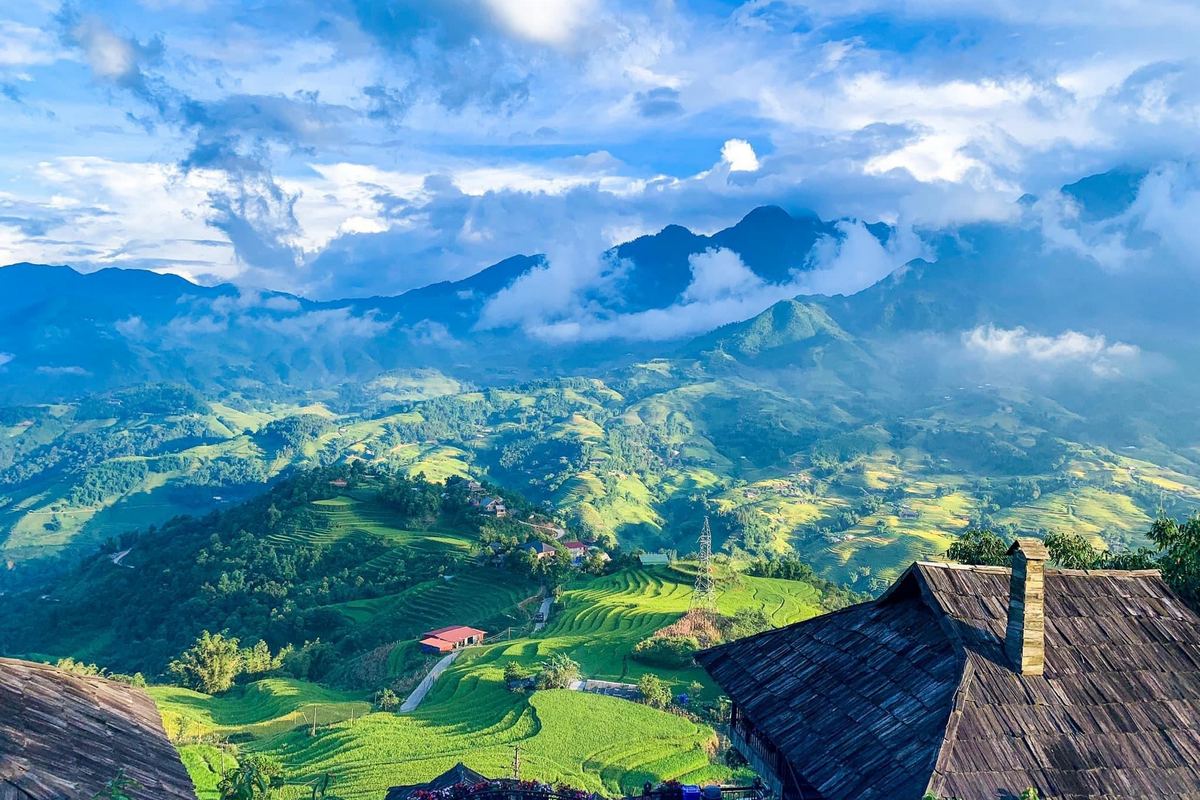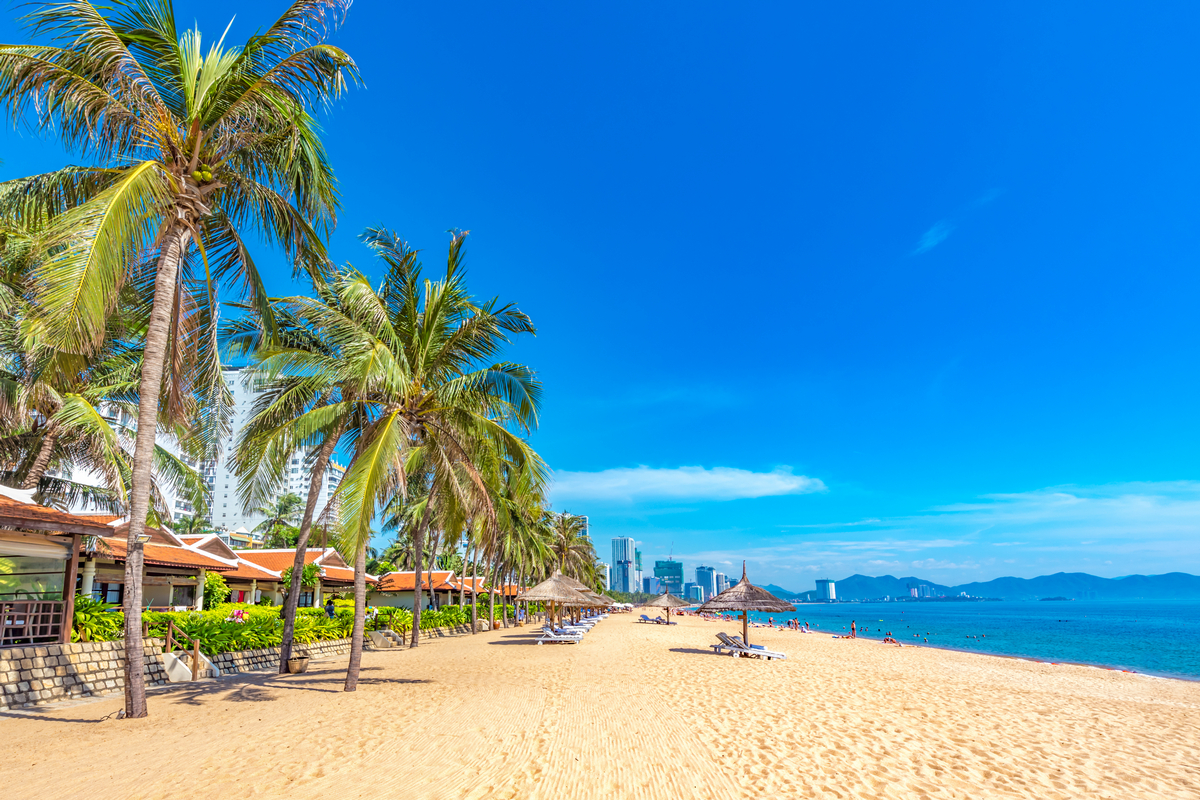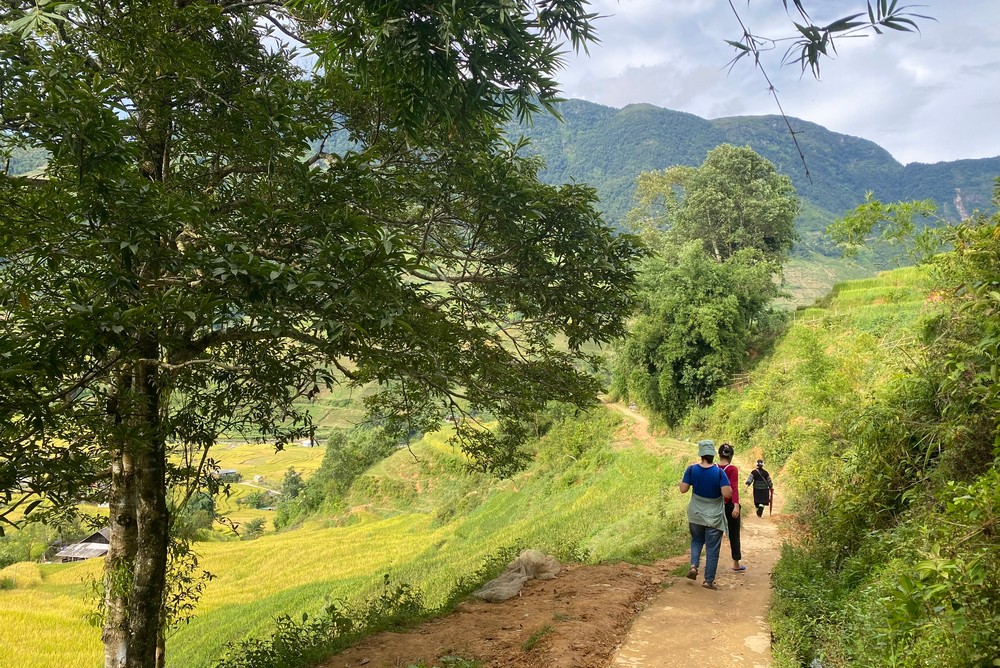सापा सीढ़ीदार चावल के खेत - सापा चावल के खेतों की यात्रा का सबसे अच्छा समय
Nestled in the heart of Vietnam’s northwestern region, the Sapa terraced rice fields are a true wonder to behold. These lush, terraced landscapes have long captivated the imagination of travelers from around the world, offering a glimpse into the remarkable agricultural heritage of this vibrant country. From the awe-inspiring natural beauty to the rich cultural traditions that permeate every aspect of life here, the Sapa terraced rice fields are a must-visit destination for anyone seeking to immerse themselves in the authentic essence of Vietnam.

Sapa, Vietnam
Best Time to Visit Sapa Terraced Rice Fields
The optimal time to visit the Sapa terraced rice fields can vary depending on your preferences and the specific experiences you hope to enjoy. However, there are a few key factors to consider when planning your trip.
Seasonal Factors
The Sapa region experiences distinct seasons, each of which offers a unique perspective on the rice fields. During the spring months of March to May, the fields are lush and verdant, with the young rice shoots just beginning to emerge from the soil. This is a particularly picturesque time, as the fields take on a vibrant green hue and the air is often filled with the gentle fragrance of blooming flowers.
As the summer months approach, the rice plants mature, and the fields transform into a sea of golden hues. From June to August, the Sapa rice terraces are at the height of their productivity, with the farmers busily tending to the harvest. This is an excellent time to witness the local farming traditions in action and to experience the energy and vitality of the region.
The autumn months of September to November bring a more subdued yet equally captivating beauty to the Sapa rice fields. The leaves on the surrounding trees begin to change color, casting a warm, earthy glow over the terraced landscapes. This is a particularly popular time for photographers, as the soft, golden light and the muted tones create a serene and contemplative atmosphere.
Finally, the winter months of December to February can offer a unique perspective on the Sapa rice fields. While the fields may be less verdant during this time, the region’s famous mist and fog can create an almost otherworldly ambiance, adding a sense of mystery and enchantment to the landscape.
त्यौहार और कार्यक्रम
In addition to the seasonal changes, the Sapa terraced rice fields are also the backdrop for a number of vibrant festivals and events throughout the year. One of the most significant is the Bac Ha Market, a lively gathering of ethnic minority groups from the surrounding villages. This colorful market, held every Sunday, is a celebration of the region’s rich cultural diversity and offers visitors a chance to immerse themselves in the local traditions.
Another popular event is the Tet Festival, the Vietnamese Lunar New Year celebration. During this time, the Sapa rice fields take on a festive atmosphere, with local families gathering to share meals, exchange gifts, and honor their ancestors. The streets are adorned with lanterns and decorations, and the sound of traditional music and laughter fills the air.
Ultimately, the best time to visit the Sapa rice fields will depend on your personal interests and the specific experiences you hope to have. Whether you’re drawn to the vibrant greens of spring, the golden hues of summer, the warm tones of autumn, or the ethereal beauty of winter, there is always something captivating to discover in this remarkable corner of Vietnam.
Trekking Options in Sapa Terraced Rice Fields
One of the most popular ways to explore the Sapa rice fields is through trekking. The region offers a variety of trekking routes, each with its own unique charm and challenges, catering to hikers of all skill levels.

Cat Cat Village, Muong Hoa Valley, Sapa
Cat Cat Village Trek
The Cat Cat Village trek is a relatively easy and accessible option, making it a popular choice for first-time visitors to the Sapa rice fields. The trek begins in the town of Sapa and takes you through the picturesque Cat Cat village, where you can witness the traditional farming practices and interact with the local ethnic minority communities.
As you make your way through the lush, terraced landscapes, you’ll be treated to sweeping views of the surrounding mountains and valleys. The trail is well-marked and relatively flat, making it an enjoyable and manageable hike for people of all ages and fitness levels.
Muong Hoa Valley Trek
For those seeking a more challenging and immersive experience, the Muong Hoa Valley trek is a must-try. This longer and more strenuous route takes you deeper into the heart of the Sapa rice fields, offering a glimpse into the daily lives of the local farmers and their communities.
The trek winds through a series of steep, winding paths that descend into the valley, offering breathtaking views of the terraced landscapes and the surrounding mountains. Along the way, you’ll have the opportunity to visit traditional villages, interact with the local people, and learn about their unique cultural traditions.
Fansipan Mountain Trek
For the more adventurous trekkers, the Fansipan Mountain trek is a true test of endurance and determination. Fansipan, often referred to as the “Roof of Indochina,” is the highest peak in Vietnam, and the trek to its summit offers a unique perspective on the Sapa terraced rice fields.
The trek to Fansipan’s summit is a multi-day affair, with challenging ascents and descents through rugged terrain. However, the reward for your efforts is the breathtaking panoramic view of the Sapa rice fields and the surrounding mountain ranges. Along the way, you’ll also have the chance to explore ancient forests, discover hidden waterfalls, and immerse yourself in the rich cultural heritage of the region.
Guided Trekking Tours
While it is possible to explore the Sapa terraced rice fields on your own, many visitors opt for guided trekking tours. These tours are led by experienced local guides who can provide invaluable insights into the region’s history, culture, and natural wonders.
Guided tours often include transportation to and from the starting point, as well as meals and accommodations along the way. They can also be customized to suit your specific interests and fitness level, ensuring that you get the most out of your trekking experience.
Whether you choose a shorter, more accessible trek or a multi-day adventure, the Sapa rice fields offer a unique and unforgettable opportunity to connect with the natural world and immerse yourself in the rich cultural tapestry of Vietnam.
Local Culture Around Sapa Terraced Rice Fields
The Sapa terraced rice fields are not merely a breathtaking natural wonder; they are also the centerpiece of a vibrant and deeply rooted local culture. The region is home to a diverse array of ethnic minority groups, each with its own distinct customs, traditions, and way of life.
Ethnic Minority Groups
The Sapa region is home to several ethnic minority groups, including the H’mong, the Dao, the Tay, and the Giay. Each of these groups has a unique cultural identity, reflected in their traditional clothing, language, and way of life.
The H’mong, for example, are known for their intricate embroidery and their traditional indigo-dyed clothing. The Dao, on the other hand, are renowned for their elaborate headpieces and their unique shamanic practices. The Tay and the Giay, meanwhile, have a long history of rice cultivation and are intimately connected to the Sapa rice fields.
Traditional Festivals and Celebrations
The local culture of the Sapa terraced rice fields is also reflected in the region’s vibrant festivals and celebrations. One of the most significant is the Tet Festival, the Vietnamese Lunar New Year celebration, which is marked by colorful parades, traditional music and dance, and the exchange of gifts and well-wishes.
Another important event is the Bac Ha Market, a weekly gathering of ethnic minority groups from the surrounding villages. This lively market is a celebration of the region’s cultural diversity, offering visitors the chance to browse an array of traditional handicrafts, sample local cuisine, and immerse themselves in the rich cultural traditions of the Sapa region.
Traditional Farming Practices
The Sapa rice fields are not merely a scenic backdrop; they are also the foundation of the local agricultural economy. The region’s farmers have developed a deep understanding of the land and its rhythms, employing traditional farming practices that have been passed down from generation to generation.
One such practice is the use of water buffaloes to plow the fields, a technique that has been in use for centuries. The buffaloes are an integral part of the local culture, with many families keeping them as part of their household. The farmers also employ a system of intricate irrigation canals to ensure that their crops receive the necessary water, a testament to the ingenuity and resourcefulness of the local people.
Artisanal Crafts and Textiles
In addition to their agricultural skills, the people of the Sapa terraced rice fields are also renowned for their artistic and craftsmanship. From the intricate embroidery of the H’mong to the intricate woodcarvings of the Tay, the region is home to a rich tradition of artisanal crafts and textiles.
Visitors to the Sapa terraced rice fields can often witness the local artisans at work, creating beautiful and functional objects that reflect the unique cultural heritage of the region. These handmade products, ranging from vibrant textiles to intricate metal work, are not only works of art but also a testament to the skill and ingenuity of the local people.
Photography Tips for Sapa Rice Fields

Lao Chai – Ta Van Village, Muong Hoa, Sapa
The Sapa terraced rice fields are a photographer’s paradise, offering a wealth of breathtaking vistas and captivating moments that are just begging to be captured. Whether you’re a seasoned professional or a passionate amateur, the Sapa region provides endless opportunities to hone your skills and capture the essence of this remarkable landscape.
Timing is Key
One of the most important factors to consider when photographing the Sapa rice fields is timing. The best light for photography can vary depending on the time of day and the season, so it’s important to plan your shots accordingly.
Early morning and late afternoon are often considered the “golden hours” in photography, as the soft, warm light can create a magical, ethereal quality to the landscape. During these times, the rice fields may be shrouded in a gentle mist, adding an extra layer of depth and mystery to your shots.
Midday, on the other hand, can be a bit more challenging, as the harsh, overhead light can create harsh shadows and washed-out colors. However, this time of day can also be an opportunity to capture the bustling energy of the local farmers at work, as they tend to their crops.
Framing and Composition
Composing your shots is crucial when photographing the Sapa terraced rice fields. The terraced landscapes offer a wealth of visual interest, from the sweeping vistas to the intricate patterns and textures of the rice plants.
One effective technique is to use the terraces themselves as a framing device, leading the eye through the frame and towards a central point of interest. This can be particularly effective when shooting from a higher vantage point, such as a hilltop or a mountain trail.
Another approach is to focus on the details, capturing the intricate textures and patterns of the rice plants, the winding irrigation canals, or the local people at work in the fields. These intimate shots can provide a more immersive and personal perspective on the Sapa terraced rice fields.
Lighting and Weather Conditions
The Sapa region is known for its variable and often unpredictable weather conditions, which can present both challenges and opportunities for photographers.
On overcast or foggy days, the diffused light can create a moody and atmospheric quality to your shots, highlighting the ethereal beauty of the rice fields. Conversely, on clear, sunny days, the harsh light can create dramatic shadows and highlights, adding a sense of drama and intensity to your images.
Experimenting with different shutter speeds and apertures can also be a valuable tool, allowing you to capture the movement and energy of the rice fields in unique and creative ways. For example, using a slower shutter speed can create a sense of fluidity and motion, while a faster shutter speed can freeze the action and highlight the intricate details of the landscape.
Engaging with the Local Community
One of the unique aspects of photographing the Sapa terraced rice fields is the opportunity to engage with the local community and capture the human element of this remarkable landscape.
Many of the local people are eager to share their stories and traditions with visitors, and they may be receptive to being photographed in the context of their daily lives. However, it’s important to always be respectful and to seek permission before taking any photographs.
Engaging with the local community can also provide valuable insights and inspiration for your photography, as you learn more about the cultural traditions and the daily rhythms of life in the Sapa region.
Accommodation Near Sapa Rice Fields
When it comes to exploring the Sapa terraced rice fields, finding comfortable and convenient accommodation is an important consideration. The region offers a range of options, from cozy homestays to luxurious resorts, each catering to the diverse needs and preferences of visitors.
होमस्टे
One of the most immersive and authentic accommodation options in the Sapa region is the traditional homestay. These family-run guesthouses provide visitors with the opportunity to experience the local way of life firsthand, while also enjoying the comfort and hospitality of a home away from home.
Homestays in Sapa typically feature simple but comfortable rooms, often with shared bathrooms and basic amenities. The real draw, however, is the chance to interact with the local hosts, learn about their customs and traditions, and savor authentic homemade meals prepared with locally-sourced ingredients.
Many homestays are located right in the heart of the Sapa rice fields, allowing guests to wake up to the serene sight of the terraced landscapes and to explore the surrounding countryside on foot or by bicycle.
Hotels and Resorts
For those seeking a more traditional accommodation experience, the Sapa region also offers a range of hotels and resorts, ranging from budget-friendly options to high-end luxury establishments.
These properties often feature modern amenities, such as en-suite bathrooms, air conditioning, and Wi-Fi, as well as on-site restaurants, bars, and recreational facilities. Many also offer stunning views of the Sapa rice fields, either from the rooms themselves or from communal areas like rooftop terraces or infinity pools.
One of the main advantages of staying in a hotel or resort is the convenience and accessibility they offer, with many properties located within easy reach of the Sapa town center and the main tourist attractions.
Eco-Lodges and Adventure Camps
For the more adventurous traveler, the Sapa region also boasts a selection of eco-lodges and adventure camps, which offer a unique and immersive experience in the heart of the rice field landscapes.
These properties are often located in more remote and secluded areas, providing guests with the opportunity to disconnect from the hustle and bustle of everyday life and to truly immerse themselves in the natural beauty of the region.
Eco-lodges in Sapa may feature sustainable, locally-sourced building materials, renewable energy sources, and a focus on minimizing environmental impact. They often also offer guided trekking, hiking, and other outdoor activities, allowing visitors to explore the Sapa rice fields and the surrounding countryside at their own pace.
Adventure camps, on the other hand, cater to those seeking a more active and adrenaline-fueled experience. These properties may offer activities such as rock climbing, zip-lining, and river rafting, all set against the stunning backdrop of the Sapa rice fields.
Regardless of the accommodation option you choose, the Sapa region offers a wealth of options to suit every traveler’s needs and preferences, ensuring that you can fully immerse yourself in the beauty and wonder of the Sapa rice fields.
Traditional Farming Practices in Sapa Rice Fields
The Sapa rice fields are not just a picturesque landscape; they are the result of centuries of traditional farming practices that have been passed down from generation to generation. These practices are a testament to the ingenuity, resilience, and deep connection to the land that the local people have cultivated over time.
Terraced Farming
One of the most distinctive features of the Sapa rice fields is the intricate system of terraced farming. This technique, which involves carving the steep, mountainous terrain into a series of flat, stepped platforms, allows the farmers to maximize the use of the available land and to effectively manage the flow of water.
The creation of these terraces is a labor-intensive process, requiring the manual excavation and shaping of the land, as well as the construction of retaining walls and irrigation canals. The resulting landscape is a testament to the hard work and ingenuity of the local farmers, who have perfected this technique over centuries of trial and error.
Water Management
The Sapa rice fields are entirely dependent on a complex system of water management, which is a crucial aspect of the traditional farming practices in the region. The farmers have developed a deep understanding of the local water sources, including streams, rivers, and underground springs, and have created an intricate network of irrigation canals and aqueducts to distribute this precious resource throughout the fields.
This system of water management is not only essential for the growth and cultivation of the rice crops, but it also plays a vital role in maintaining the overall health and sustainability of the Sapa rice fields. By carefully controlling the flow of water, the farmers are able to prevent erosion, manage soil fertility, and ensure the long-term viability of their agricultural practices.
Crop Rotation and Diversification
In addition to their expertise in water management, the farmers of the Sapa terraced rice fields also employ a range of other traditional farming practices that contribute to the overall health and productivity of their land.
One such practice is crop rotation, which involves alternating the types of crops grown in a particular field over time. This helps to replenish soil nutrients, prevent the build-up of pests and diseases, and maintain the long-term fertility of the land.
The farmers in Sapa also practice a high degree of crop diversification, growing a wide variety of crops alongside their primary rice cultivation. This includes a range of vegetables, herbs, and other cash crops,as well as raising livestock such as pigs, chickens, and water buffalo. This diversification not only provides the farmers with a more stable source of income but also helps to improve soil health, reduce the risk of crop failure, and promote biodiversity in the agricultural landscape.
Organic Farming
Many of the farmers in the Sapa rice fields adhere to traditional organic farming practices, eschewing synthetic pesticides, fertilizers, and herbicides in favor of natural and sustainable methods. This commitment to organic farming not only produces healthier and more environmentally-friendly crops but also reflects a deep respect for the land and a desire to preserve its natural integrity for future generations.
By utilizing techniques such as composting, crop rotation, intercropping, and natural pest control, the farmers in Sapa are able to maintain the health and fertility of their soil without relying on harmful chemicals. This approach not only benefits the local ecosystem but also produces high-quality, nutrient-rich crops that are prized for their flavor and nutritional value.
Community Collaboration
Another key aspect of traditional farming practices in the Sapa terraced rice fields is the spirit of community collaboration and mutual support that underpins agricultural life in the region. Farmers often work together on large projects such as terracing, irrigation, and harvesting, pooling their resources, knowledge, and labor to ensure the success of the entire community.
This sense of solidarity extends beyond just the practical aspects of farming; it also encompasses a shared cultural heritage, a respect for tradition, and a commitment to preserving the unique way of life that has sustained the people of Sapa for generations. By working together and supporting one another, the farmers of the Sapa rice fields have created a resilient and interconnected community that thrives in harmony with the land.
In conclusion, the traditional farming practices of the Sapa terraced rice fields are not just a means of sustenance; they are a way of life, a cultural legacy, and a testament to the enduring bond between the people and the land. By embracing these time-honored techniques and principles, the farmers of Sapa have created a sustainable and harmonious agricultural system that nourishes both body and soul, ensuring the continued prosperity of this remarkable region for years to come.





